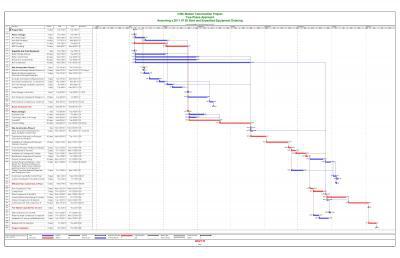Construction period
(construction period) The time from the start of construction to the completion of all the contents specified in the contract, and the time to reach the completion acceptance criteria, expressed in days.
For example, the construction period of a unit project refers to the total number of effective days from the official start of construction to the completion of all the design content of the contracted project and reaching the national acceptance standard. The construction period is one of the important accounting indicators for construction enterprises. The length of the construction period directly affects the economic benefits of construction enterprises, and is related to the completion of the plan for the utilization of new production capacity of the national economy and the exertion of economic benefits. There are two ways to calculate the construction period: ①Calculate the total calendar days from start to completion, without deducting the number of downtime, called "calendar construction period"; Example: 300 calendars of planned construction period, which means the contract’s start date to the end date, Including weekends, the sum of the days of the month and month. ②Deducting the number of days without construction during holidays and the number of days suspended due to design, materials, weather and other reasons from the total calendar days is called the "actual construction period". Generally, the contract stipulates that the calendar construction period is used to facilitate the inspection of the implementation of the contract; the actual construction period excludes the influence of objective factors, which facilitates the analysis of the implementation of the fixed period of the construction period.
Construction period hierarchical control
1. Project classification
The project grade is divided into three grades according to the project scale and project characteristics.
1) Control projects include:
Projects with large scale and outstanding technical difficulty have a decisive influence on the construction progress of the whole line.
2) Key projects include:
Projects that are large in scale, have certain technical difficulties, and play an important role in controlling the construction progress of the entire line.

3) General projects include:
Other projects except control and key projects.
According to its own project characteristics, the project management department refers to the above regulations to specify the project classification within the pipeline.
2. Implementation of hierarchical management 1) The project manager of the control project management team is in charge of the project management department. Each control project is in charge of the other leaders of the project management department. The team members are composed of the project management department, safety and environmental protection department, materials and equipment It is composed of heads of department, planning and contract department, comprehensive department and branch.
2) The key project management team is in charge of the head of the project manager department, and the team members are composed of relevant professional engineers and branch supervisors.
3) The general engineering management team is in charge of the professional engineers of the project manager department, and the team members are composed of professional engineers of the branch.
4) According to the project classification, each branch shall establish and improve the project management team at all levels to clarify the main project projects that each team is responsible for.
(1) Determine the construction progress goal according to the start date, total construction period and completion date determined in the construction contract, clarify the planned start date, planned total construction period and planned completion date, and determine the start of the project in phases and batches. Completion date.
(2) Preparation of construction schedule. The construction schedule should be determined comprehensively according to factors such as process relationship, organizational relationship, overlap relationship, start and end time, labor plan, material plan, machinery plan, and other guarantee plans.
(3) Submit a construction start application report to the supervising engineer, and start construction on the date specified in the start order issued by the supervising engineer.
(4) Implement construction schedule. The manager department and subordinate projects are distributed hierarchically for construction deployment, organization and coordination, production scheduling and command, and decision-making to improve construction procedures and methods, and apply technical, economic and management methods to achieve effective schedule control. The project branch must first establish a scientific organization system and strict work system for schedule implementation and control, and then systematically control the entire construction process according to the construction schedule control target system. Under normal circumstances, the schedule implementation system should perform monitoring and analysis functions and run cyclically, that is, as the construction activities progress, the information management system will continuously feed back the actual construction progress information to the schedule controller according to the information flow procedure, and then collect statistics. , After comparative analysis, if the progress is confirmed without deviation, the system will continue to operate; once the actual progress is found to be deviated from the planned progress, the system will perform its control function to analyze the cause of the deviation and its impact on subsequent construction and the total construction period. If necessary, the original plan can be adjusted accordingly, the deviation correction plan and the implementation of technical, economic, contractual guarantee measures, and the coordination measures to obtain the support and cooperation of relevant units can be made. After confirming that it is feasible, the adjusted new The schedule is input to the schedule implementation system, and the construction activities continue to run under the new control. When the new deviation appears, repeat the above process until the construction project is completed. The schedule control system can also handle schedule adjustments that need to be made due to contract changes.
(5) After all tasks are completed, a progress control summary should be conducted and a progress control report should be prepared.
